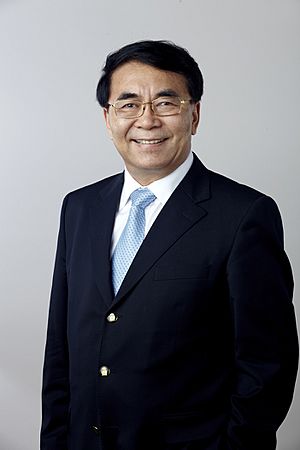Bai Chunli facts for kids
Quick facts for kids
Bai Chunli
白春礼 ForMemRS HonFRSC HonFRSE
|
|
|---|---|

Bai Chunli in 2014, portrait via the Royal Society
|
|
| Born | September 26, 1953 Dandong, Liaoning, China
|
| Nationality | Chinese |
| Alma mater | Peking University (UG) Chinese Academy of Sciences (MS, DSc) |
| Awards |
|
| Scientific career | |
| Fields |
|
| Institutions | |
Bai Chunli (Chinese: 白春礼) is a famous Chinese scientist. He was born on September 26, 1953. He is a physical chemist, which means he studies how chemicals behave using physics. He is also a nanotechnology scientist. Nanotechnology is about working with tiny things, even smaller than a speck of dust! He has also been an important leader in science organizations.
Bai Chunli is a professor at the Chinese Academy of Sciences Institute of Chemistry. From 2011 to 2020, he was the president of the Chinese Academy of Sciences. This is a very important science organization in China. He also led the University of the Chinese Academy of Sciences for many years. Outside of China, he was the president of The World Academy of Sciences from 2012 to 2018. He has helped science grow both in China and around the world.
Early Life and Education
Bai Chunli's father was a teacher. He taught Bai Chunli about old poems when he was young. In 1966, Bai Chunli started middle school. He finished high school in just four years.
After high school, he joined a program called the Down to the Countryside Movement. This program sent young people to work in the countryside. From 1970 to 1974, he worked in Inner Mongolia. He was a driver and helped with office work.
In 1974, Bai Chunli got a special chance to go to Peking University. He was chosen by the people he worked with. He studied chemistry there. In 1978, he graduated from Peking University.
Later, he continued his studies at the Chinese Academy of Sciences. He earned his Master of Science degree in 1981. Then, he received his Doctor of Science degree in 1985.
Career in Science
After finishing university in 1978, Bai Chunli started his research career. He joined the Chinese Academy of Sciences. From 1985 to 1987, he did more research in the United States. He worked at the Jet Propulsion Laboratory at the California Institute of Technology.
In 1996, he became the Vice President of the Chinese Academy of Sciences. This was a big step in his career. In 2011, he became the President of the Chinese Academy of Sciences. He held this important position until December 2020.
Bai Chunli has also taught at many top universities. He has been a professor at Peking University, Tsinghua University, and the University of Science and Technology of China. He also helps lead the science journal National Science Review.
Research in Nanotechnology
Bai Chunli's main research is in nanotechnology. This field deals with materials and devices that are incredibly small. He also works with scanning probe microscopy. This is a special way to look at and even move tiny atoms and molecules.
He has written many books about his research. These books are in both Chinese and English. His work has helped us understand how tiny molecules are put together. He has also explored how to use nanotechnology in new ways.
Bai Chunli is known as one of the first scientists to work with scanning probe microscopy. He helped develop new tools like the scanning tunneling microscope (STM). These tools let scientists see and work with things at the atomic level. He has also worked to help scientists in China and other countries work together.
His research has been published in many scientific journals. This means other scientists have reviewed and approved his work.
Awards and Honors
Bai Chunli has received many awards and honors for his scientific work. These show how important his contributions are to science.
- He became an Academician of The World Academy of Sciences in 1997.
- He also became an Academician of the Chinese Academy of Sciences in 1997.
- In 2006, he was named an International Member of the United States National Academy of Sciences.
- He became an Honorary Fellow of the Royal Society of Chemistry in 2007.
- In 2014, he was named a Foreign Member of the Royal Society, which is a very old and respected scientific group in the UK.
- He is also an Honorary President of the University of Science and Technology of China.
His nomination for the Royal Society said that he is a pioneer in nanoscience. It mentioned that he designed and developed China's first atomic force microscope (AFM) and scanning tunneling microscope (STM). These tools were the first in China to help scientists work with single atoms and molecules. He also found ways to study how molecules arrange themselves on surfaces.
He has also held important leadership roles. He was the President of the Chinese Chemical Society. He also served as President of the Chinese Academy of Sciences for many years. In 2012, he became the first Chinese President of the Academy of Sciences for the Developing World (TWAS).


